Tokyo's Hachioji Festival 2025: Dates, Highlights, and Access

The Hachioji Festival, one of Tokyo's leading summer festivals, will be held in 2025 over three days from August 1 (Friday). Learn the key events and tips on food stalls and access.
Join Tokyo's Vibrant Hachioji Festival in August
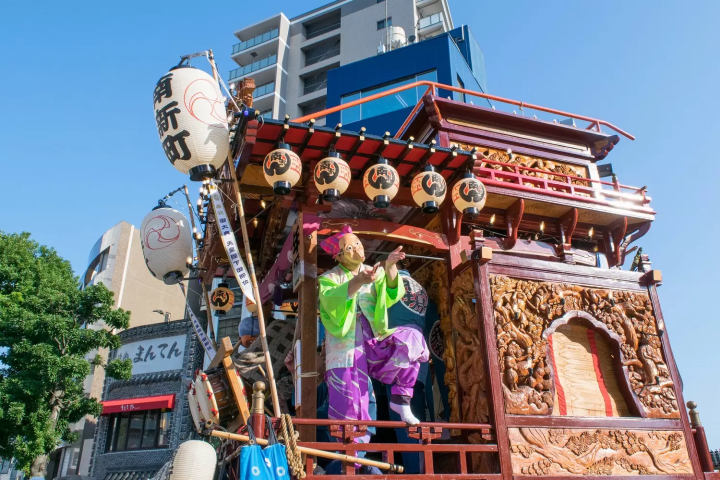
Photo by Pixta
Tokyo's Hachioji Festival is renowned as one of the foremost float festivals in eastern Japan. In 2025, the Hachioji Festival will be held August 1 - 3 and will feature food stalls and events.
Read on to learn the history of this fascinating festival, key events to look out for, and details about the scale of the food stalls. We've also added information on how to access the venues.
Tokyo's Hachioji Festival: Features and Highlights
1. Hachioji Festival 2025 Dates
2. Food Stalls at the Hachioji Festival
3. The History of the Hachioji Festival
4. Key Attractions of the Hachioji Festival
5. How to Access the Hachioji Festival
6. Parking Facilities near the Hachioji Festival
1. Hachioji Festival 2025 Dates
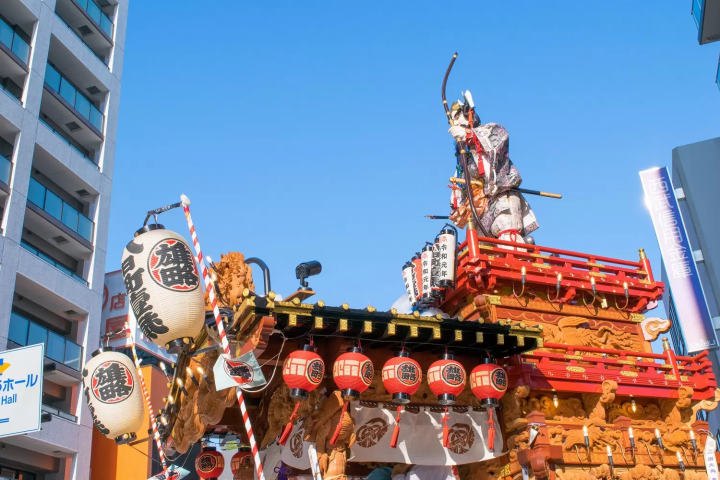
Photo by Pixta
The Hachioji Festival 2025 will be held over three days on August 1st (Friday), 2nd (Saturday), and 3rd (Sunday).
On August 1, there will be an Ice Sculpture Exhibition, on August 2, the Folk Dance event and a Float Parade, and on August 3, the Sengan Portable Shrine event will take place.
The Ice Sculpture Exhibition aims to promote ice sculpting and improve related techniques, featuring live sculpture demonstrations at the venue.
The Sengan Portable Shrine event involves around 1,600 people carrying a portable shrine weighing approximately 3 tons, creating a powerful and impressive spectacle.
Official website: Hachioji Festival (Japanese)
Food Stalls at the Hachioji Festival
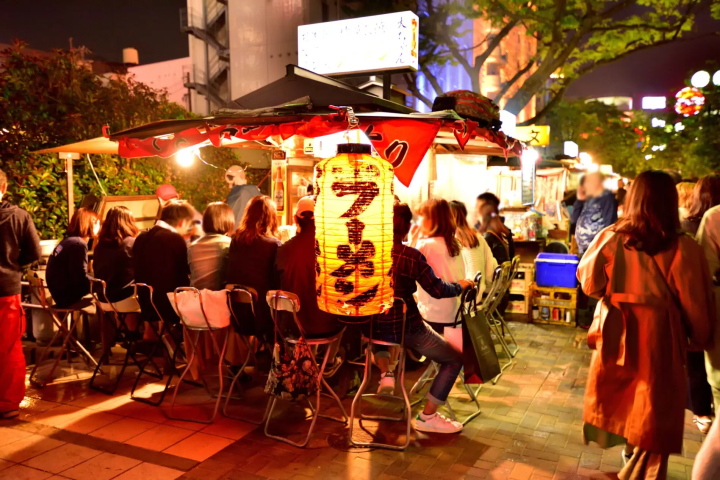
Photo by Pixta
Like summer festivals held all over Japan, the Hachioji Festival also features a wide variety of food stalls.
Mainly lining the Koshu Kaido Street, the festival's main thoroughfare, there are approximately 250 stalls where you can enjoy popular festival foods like yakisoba (fried noodles) and takoyaki.
The food stalls operate from 12:00 to 21:00, aligning with the festival's hours over all three days.
The History of the Hachioji Festival
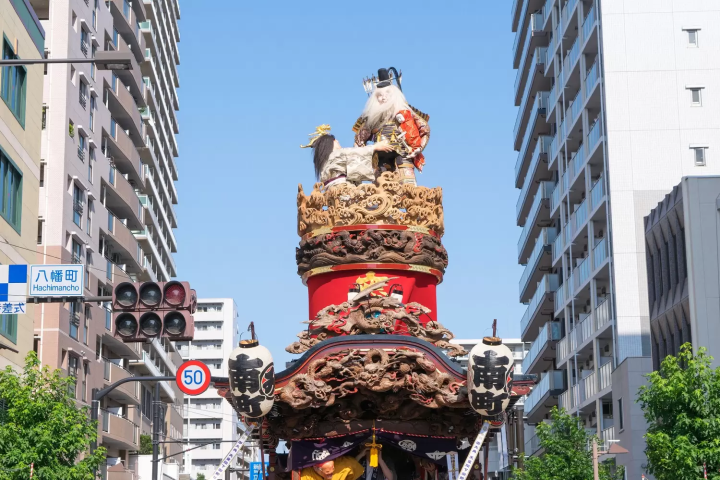
The Hachioji Festival traces its origins back to an event that began in 1961, known as the Hachioji Citizens' Festival.
In Hachioji, separate festivals were held for the Hachiman Yakumo Shrine (the Shimo no Matsuri Festival) and the Taga Shrine (the Kami no Matsuri Festival), both of which have carried on the tradition of float festivals since the Edo period (1603-1868).
In 1968, these two festivals were merged, and the float parade, which is still a significant part of the Hachioji Festival, continues the traditions of these original festivals. The festival took its current form in 2002 and received the Regional Traditional Performing Arts Award in the same year.
Additionally, in 2016, as part of the prelude to the city's 100th-anniversary celebration, the Folk Dancing event called Min'yo Nagashi (where dancers in yukatas perform a traditional dance over about 2 km) set a new Guinness World Record for the largest number of people dancing in a Bon festival (*1). This award attracted considerable attention not only from Hachioji residents but also from beyond the city.
*1 Bon festival: An event held as part of the Obon celebrations in the summer, when the souls of ancestors and departed family are remembered in Japan.
Key Attractions of the Hachioji Festival

Photo by Pixta
When it comes to the highlights of the Hachioji Festival, two events stand out and cannot be overlooked:
- Buttsuke - the Float Competition
- Hachioji's Representative Dance - the Min'yo Nagashi Dance Parade
Buttsuke - the Float Competition
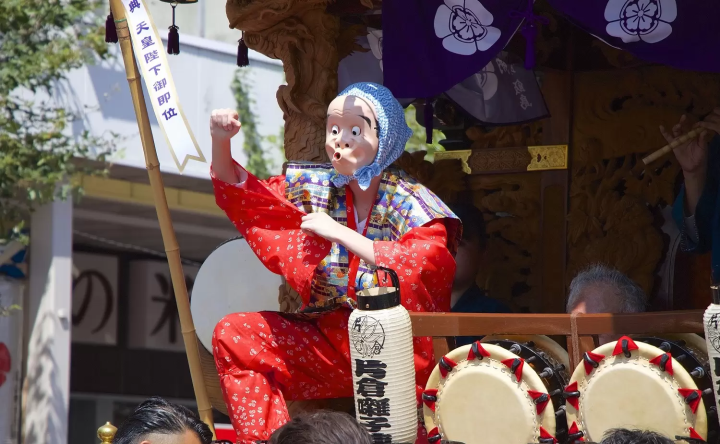
Photo by Pixta
One of the key attractions of the Hachioji Festival is the Buttsuke, where floats compete with each other during their passing while their respective festive hayashi music (*2) plays.
This spectacle can be witnessed around the Koshu Kaido Street (from the Hachioji Station entrance to the Oiwake intersection) and along the Nishi Hoshasen You Road.
It's important to note that unlike the Buttsuke at the Fushiki Hikiyama Festival in Toyama known for its fierce float clashes, the Buttsuke at the Hachioji Festival doesn't involve physically bumping the floats into each other.
There are a total of 19 floats featured in the Hachioji Festival. Their dimensions are approximately 3 m wide, 4.5 m long, and 4 m high, with some floats reaching over 7 m in height when the float dolls are atop.
Among these 19 floats are six sculpted floats created by the renowned craftsman Mitsushige Sato. The sight of these sculpted floats illuminated by lights is truly captivating.
During the Buttsuke, the floats come close to each other, playing their respective festival music. If a float gets caught up in the music of another, it is considered a loss. Sometimes, not only two but even three or four floats may compete simultaneously, creating a breathtaking display of power and coordination.
*2. Hayashi is one of Japan's traditional music styles, accompanying performances at festivals and on stage. It is played using instruments like drums, flutes, and bells. Hayashi is also the name of the performers playing the hayashi music.
Hachioji's Representative Folk Dance - The Min'yo Nagashi Dance
As mentioned earlier, Hachioji's Folk Dance Parade called Min'yo Nagashi, which broke the Guinness World Record for the largest number of dancers, is a highlight of the Hachioji Festival.
Participants in yukatas dance along the Koshu Kaido Street to traditional folk songs, creating a lively and festive atmosphere.
Approximately 4,000 dancers, dressed in vibrant yukatas, move along a 2 km route to tunes like the Hachioji Dance (Shin-Hachioji Ondo), Takao-san Ondo, and Taiyo Odori. The sight of these many dancers in colorful yukatas is a beautiful and dazzling spectacle.
How to Access the Hachioji Festival

Photo by Pixta
Below we explain how to get to the Hachioji Festival via public transportation (trains and buses) and by car. It is especially important to note details when not using trains.
Access by Train
The venue for the Hachioji Festival is a 5-minute walk from the north exit of Hachioji Station on the JR Chuo Line.
If coming from Tokyo, using the JR Chuo Line special rapid service is convenient. It takes around 50 minutes from Tokyo Station and about 60 minutes even on the rapid service. From Shinjuku Station, it takes just under 40 minutes on the special rapid train and slightly under 50 minutes on the regular rapid service.
When traveling from Yokohama to Hachioji Station, you can utilize the JR Yokohama Line. The journey takes about 50 minutes on the rapid service from Yokohama Station and around one hour on the local train.
If coming from Machida Station, the trip is approximately 20 minutes on the rapid service and about 25 minutes on the local train.
From Keio Hachioji Station, it's a 10-minute walk to the venue. You can also take an express train from Shinjuku Station on the Keio Line, which takes around 35 minutes.
Access by Car
Using the Chuo Expressway, it takes approximately 35 minutes from the Shuto Expressway Shinjuku Entrance to the Hachioji Interchange Exit 1.
If you opt for regular roads, it will take around 100 minutes to reach the vicinity of Hachioji Station. However, during the Hachioji Festival, there are traffic restrictions along the Koshu Kaido Street, leading to heavy congestion on the roads near the venue.
It is not highly recommended to drive to the event due to these traffic conditions. If you must drive, an alternative is to park your car at Toyoda Station, closer to Tokyo, and then take the train to the festival. Another option is to utilize the nearby parking lots mentioned later.
Access by Bus
During the Hachioji Festival, certain bus routes may be diverted due to traffic regulations. Even for local residents, using buses might not be the most efficient option.
It is recommended to take a train from the nearest station for smoother access. If you must use the bus, consider traveling during off-peak hours to avoid congestion.
Parking Facilities near the Hachioji Festival

Photo by Pixta
The following are a few recommended parking facilities for the Hachioji Festival on the event days:
1. Hachioji Station North Exit Underground Parking Lot
The municipal Hachioji Station North Exit Underground Parking Lot is one of the closest parking facilities to the venue of the Hachioji Festival.
It is located just a few minutes' walk from JR Hachioji Station's north exit and has a capacity of 429 vehicles, making it a large facility.
Please note that it operates from 6:00 to 24:00 and is not open 24 hours, so be mindful of the operating hours. On Saturdays, Sundays, and holidays, the maximum rate applies without time restrictions.
If you plan on parking for an extended period on August 3rd (Saturday) or 4th (Sunday), caution is advised. The fee structure is 100 yen for every 15 minutes (100 yen for every 30 minutes between 00:00 and 7:00), with a maximum fee of 1,800 yen on weekdays.
2. Municipal Asahi-cho Parking Lot
The municipal Asahi-cho Parking Lot is located approximately a 5-minute walk from Hachioji Station, making it convenient and close to the venue of the Hachioji Festival. With a capacity of 150 vehicles, it operates 24 hours a day.
Please note that there is a vehicle height restriction, and vehicles exceeding 1.57 meters in height cannot park there. If you plan to use a large vehicle, caution is necessary. The fee structure is 100 yen for every 15 minutes (100 yen for every 30 minutes between 00:00 and 7:00), with no maximum fee set.
3. Times Southern Sky Parking
The Times Southern Sky Parking is situated just a few minutes' walk from Hachioji Station's south exit, providing easy access to the venue of the Hachioji Festival. It has a capacity of 185 vehicles and operates 24 hours a day. The standard fee is 440 yen per hour, with subsequent 30-minute periods costing 220 yen. The maximum daily fee is 1,200 yen (until 24:00).
Enjoy the Hachioji Festival!
The highlights of the Hachioji Festival, taking place over three days from August 2nd to 4th in 2024, include the historical charm of the floats, the power of the Buttsuke float competition, the vibrant allure of the Guinness-record-breaking Folk Dance Parade, and the array of 250 food stalls.
With over 800,000 attendees expected, prepare for crowds and ensure a smooth journey as you enjoy the festivities.
Read also
Written by Kakutama editorial team
This is the official account of MATCHA's editorial department. Our articles feature useful travel information for visitors to Japan, from how-to guides to recommended places to visit.






































![[2026 Edition] FORMUAL 1 JAPANESE GRAND PRIX Information](https://resources.matcha-jp.com/resize/720x2000/2025/10/05-245984.webp)


![[2025 Update] Namba's spectacular illuminations! "Namba Hikari Tabi" with approximately 1 million shining lights](https://resources.matcha-jp.com/resize/720x2000/2025/12/12-252825.webp)